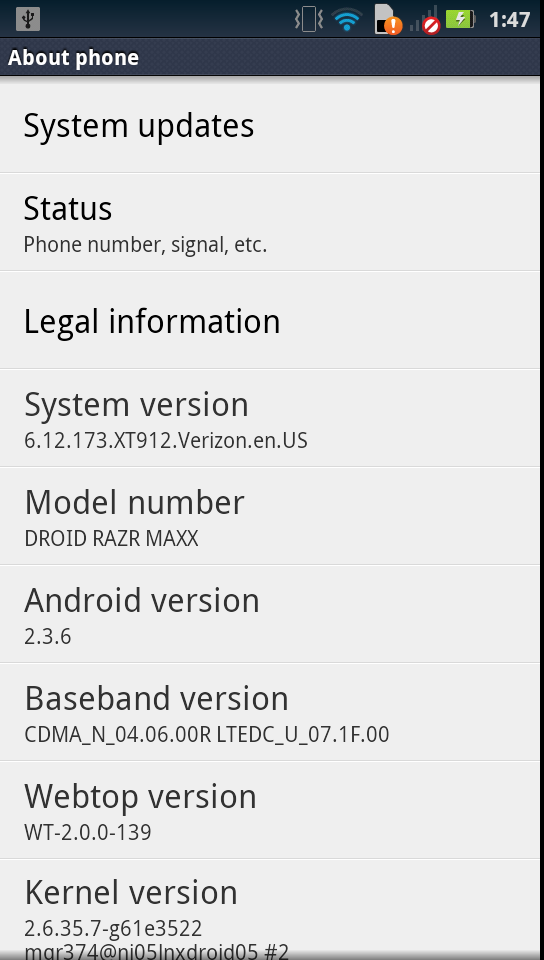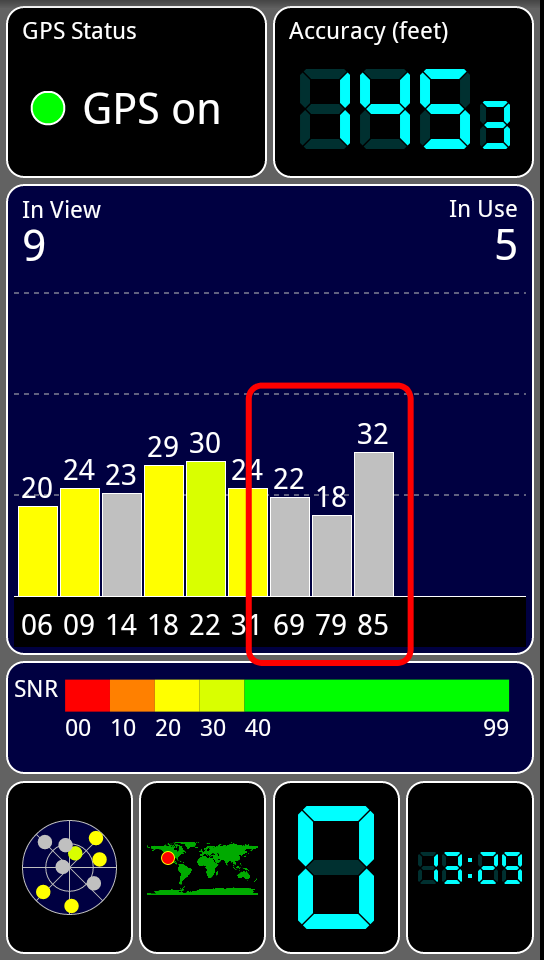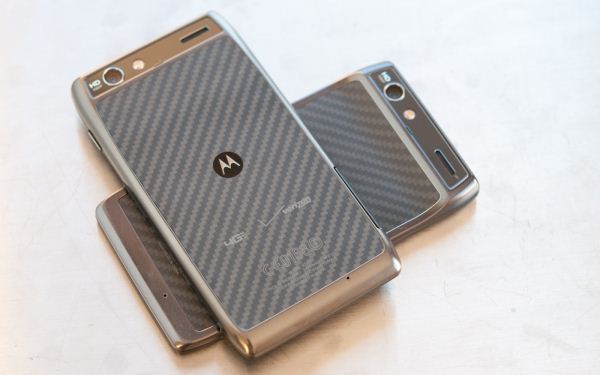Motorola Droid RAZR MAXX Review - 1.8x The Battery
by Brian Klug on February 14, 2012 2:01 PM EST- Posted in
- Smartphones
- Motorola
- Android
- Mobile
- motorola droid RAZR
- RAZR MAXX
- RAZR
Since the RAZR Review
The Droid RAZR and RAZR MAXX as of this writing have been both pushed the same “6.12.173.XT912.Verizon.en.US” update, which makes a number of changes and improvements that mitigate some of the things I complained about in the initial Droid RAZR review. The core Android version is now 2.3.6. I’ve re-run our performance tests, and nothing has really changed here, unsurprisingly.


First, the update changes the Settings page aesthetics slightly, including some icons that weren’t there previously. There’s also a change to some of the other icons on the home screen, and the cDRX features I’ve written about before.
I noted some frustration with the RAZR’s camera app in the original review, this has been significantly improved in the latest update. Stability is much improved, UI items no longer completely disappear and the camera app hasn’t crashed at all. In addition I no longer see the RAZR miss focus entirely like I did before, which was a big problem at times.
GNSS
Some other OEMs have written about GLONASS support on their hardware, and I forgot to note in the initial RAZR review that this device also includes GNSS (GPS+GLONASS) support the same way courtesy the MDM6600. Until recently basically all satellite based location has used GPS, which consists of a constellation of 27 satellites. GLONASS is its Russian cousin, with 24 satellites. The two can be used in conjunction to get faster 3D fixes, better coverage, and greater accuracy. We'll see more and more GNSS solutions start shipping in 2012 as well.

GLONASS satellites are used here, circled in red
If you fire up GPS Test, satellites numbered 65-88 are GLONASS. Qualcomm’s GNSS only uses GLONASS when there either aren’t enough visible GPS satellites for a fix, or SNR is bad (basically an urban canyon or indoors scenario), so you’ll often see a set of bars pop in or out depending on how good the normal GPS SNR is. This implementation is the same for all of the Qualcomm SoCs and MDMs that include GNSS support.
Final Words
If you want a smartphone that’s uncompromising about battery life and also includes 4G LTE connectivity, the Droid RAZR MAXX is a no brainer, especially over the Droid RAZR sans MAXX. There’s just no other device out there right now that lasts as long and isn't a feature phone or crippled in some way, and in a world where everything is being fabbed on a 4x nm process, battery life at the high end is entirely a function of battery capacity. Until 28nm SoCs and basebands start arriving in devices later this year, things aren’t going to change much, either - you just need a big battery to post the kind of numbers the MAXX does in our battery life tests.
The RAZR MAXX is a device after my own heart, as I almost always end up buying or seeking out whatever extended battery option is available for whatever device I carry. There’s just nothing more frustrating than constantly worrying about having a dead device with no charger in sight. On trips and visits to cafes with intermittent or barely working WiFi, hotspot battery life ends up being probably the most important thing to me, and remains the big battery life equalizer.
Right now on Verizon the top tier of Android phones in my mind really is a two horse race. On one side is the Galaxy Nexus which is awesome purely because it’s running Android 4.0 with no customizations. On the other hand, the RAZR MAXX is a device with very similar specifications (and the same CPU, GPU, and clocks), but with a much larger battery. That's a big simplification, but superficially those are the biggest factors. As soon as the RAZR MAXX gets its Android 4.0 update, I think it’ll be hard to argue in favor of the Galaxy Nexus over the MAXX for most customers, though the former will continue to be the platform that gets updates first, comes with an unlocked bootloader, making it the obvious enthusiast choice. For people who don't find themselves presented with a charger at the end of every day, or can't charge the device on a regular schedule, the MAXX is also a no-brainer.
If anything, I hope that the RAZR MAXX sets a new trend for devices with internal batteries, which a lot of recent devices have started shipping with. If you’re going to make a device and seal the battery inside, at least make it huge.











45 Comments
View All Comments
Brian Klug - Tuesday, February 14, 2012 - link
The caveat I meant to add was - among android phones. Fixed.-Brian
solinear - Wednesday, February 15, 2012 - link
The question that I have about the longevity of the 3g/4g is how strong the signal is. If the iPhone 4S has half the range of the RAZR, then we're really making an apples to oranges comparison.mczak - Tuesday, February 14, 2012 - link
Too bad it seems the larger battery comes with quite a large price increase.Actually the no contract price increase seems somewhat reasonable (649$ vs 599$) though it seems verizon tacks on another 50$ so it's 199$ vs 299$ with the same contract.
DanNeely - Tuesday, February 14, 2012 - link
They do the same with all their android devices. Charge an early adopter premium on the latest and greatest until it's dethroned after a month or two; then significantly discount older models for customers who balk at paying anything upfront for their new phone.peevee - Tuesday, February 14, 2012 - link
Finally a device which upgrades where it really matters! If it had ICS and were available on AT&T, I would go and buy it now. And I am very picky about this stuff.secretmanofagent - Tuesday, February 14, 2012 - link
Does this have the same screen splotches in low light as the Droid RAZR does? Went through a couple because of it.peevee - Tuesday, February 14, 2012 - link
"Samsung Galaxy S II Epic 4G Touch" should have been properly named "Samsung Marketing Could Not Choose A Name Epic Fail II".mlj11 - Wednesday, February 15, 2012 - link
Please... You really think all the different stupid names are chosen by Sammy?Trust me when I say that if Sammy could've had their way, they'd just slap on GALAXY SII on all the assorted variations of the phone and be done with it, reaping the rewards of a streamlined marketing campaign focused on a single brand in the process.
Of course it's the carriers who want different names for their versions! They need this in order to "differentiate" from the competition. Poor Americans, always getting screwed over by the greedy - and inordinately powerful - carriers.
DanNeely - Tuesday, February 14, 2012 - link
"I guess that really illustrates what’s wrong with the way that OEMs are specifying device “thickness” these days more than anything, as most intentionally cite the device thickness at its thinnest point. One other OEM has told me it’s going to move to a mean thickness measurement, which seems to be more representative but potentially complicated."Personally, I'm waiting for one of the OEMs to add back an old school slide out antenna so they can claim their phone is only 1 mm thick. (Minimum antenna diameter on a 2005 vintage Samsung.)
Brian Klug - Tuesday, February 14, 2012 - link
I wouldn't be opposed to a phone with an antenna bulge, if it actually helps things. Anyone remember the HTC Apache? :) http://i.imgur.com/5UJ4c.jpg-Brian